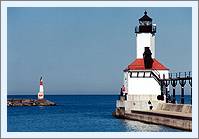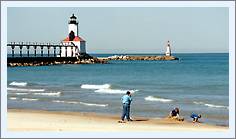|
Historical
Information

Since the founding of the settlement of Michigan City, the
townsfolk had what at times seemed to be a losing battle with wind and
wave-born sand which clogged the entry to Trail Creek, stifling their
plans to make their city the important hub of maritime commerce of their
dreams.
The first steps towards federal harbor improvements at
the river mouth were undertaken in 1836, when $20,000 was appropriated
to begin the work. With additional appropriations increasing the
available funding to $110,000 by 1839, the Topographical Engineers
completed the erection of a pair or parallel timber crib piers on each
side of the river mouth. With the river thus opened up to greater
commerce, the citizenry of Michigan City was looking forward to boom
times, and in that first year alone, 150 barrels of whiskey, 50 barrels
of cider and vinegar, 50 barrels of apples, 7,887 bushels of salt, 1.344
bushels of bulk goods, and 1,105 tons of merchandise were shipped into
the harbor, and vessels departed loaded with wheat, corn, barley, oats,
rye, pork, lard, flour and butter.
While a government dredge had been assigned to the
harbor, it appeared as though it was of little advantage, as the depth
of water between the piers had decreased to the point that it was barely
sufficient to float a scow into the river by 1842. After an additional
appropriation of $10,000 in 1844, the piers were extended further into
the lake, and through frequent dredging a minimum navigable depth of
seven feet throughout the entrance was maintained. However, it was clear
that continued extension of the piers would afford insufficient
protection, and the Engineers recommended an appropriation of $177,000
for the erection of a 1,000-foot breakwater outside the pier entrance to
both retard sand deposition and serve as a harbor of refuge to mariners
during storms out on the lake. Reticent to appropriate the full sum,
Congress did approve an expenditure of $20,000 for harbor improvements
at Michigan City in 1852, and work on rebuilding and further extension
of the piers began the following year.
 With the entrance between the new piers a considerable
distance from the Michigan City Lighthouse at the river mouth, the
Lighthouse Board decided that a pierhead beacon would be needed to mark
the entry, and an appropriation of $2,000 was made to this end on August
3, 1854. However, with the work still far from completion, installation
of the light was postponed until completion of pier construction, and
the appropriation was returned to the Treasury, and with the outset of
the Civil War in 1861, the Engineers were called to battle, and work on
the harbor came to a grinding halt. With the entrance between the new piers a considerable
distance from the Michigan City Lighthouse at the river mouth, the
Lighthouse Board decided that a pierhead beacon would be needed to mark
the entry, and an appropriation of $2,000 was made to this end on August
3, 1854. However, with the work still far from completion, installation
of the light was postponed until completion of pier construction, and
the appropriation was returned to the Treasury, and with the outset of
the Civil War in 1861, the Engineers were called to battle, and work on
the harbor came to a grinding halt.
Not content to sit back and allow the work on their
harbor to languish for an undetermined period of time, local business
interests formed the Michigan City Harbor Company, and with a stock
capitalization of $300,000 in stock, approached the federal government
to receive permission to build atop the existing piers in order to
continue the harbor improvements in accordance with Engineer's plan.
Congress not only gave approval to the endeavor, but appropriated an
additional $75,000 for the project, but insisted on making the
availability of the funds contingent on the Harbor Company's proving
that it had expended a minimum of $100,000 of its own operating capital
on the works.
While the Harbor Company was able to meet the demands
of the contingency in June of 1867, with the war over, the company was
reticent to continue expenditure of its own funds, and instead turned to
applying all possible pressure on the Federal Government to complete the
work. On behalf of the Company, the Indiana General Assembly passed a
resolution on February 1, 1869 that Congress be "respectfully
requested to make such an appropriation as may be necessary to complete
the harbor at Michigan City." Additionally, Michigan's Senators and
Representatives were requested "to vote and use their official
influence in favor of passage of said appropriation." Congress
responded favorably, assigning Major David C Houston to the task of
completing the work, and after conducting a situation assessment in May
1870, Houston concurred that the construction of an outer breakwater was
the only real solution, stating that "It seems impossible to
maintain the required depth of water at the harbor, except by constant
dredging ... and the only remedy seems to be the construction of an
outer harbor."
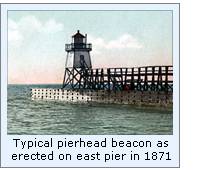 Thus, the
Army Corps of Engineers returned to Michigan
City in 1870, and with progress underway on extending both piers, the
Lighthouse Board again requested an appropriation for establishing a
beacon at the outer end of the longer pier on its completion. Funding
for the beacon was approved on March 3, 1871, and the structure was
erected that fall. Typical of pierhead beacons erected throughout the
district, the structure took the form of a 27-foot tall white-painted
timber framed pyramid beacon. With its upper section enclosed with
clapboard sheathing, a small enclosed room was thus formed within the
structure to serve double duty as both a service room and as shelter for
the keeper when forced to spend time tending the light in rough weather.
Atop this service room, an octagonal iron lantern was centered on a
square gallery, and outfitted with a fixed red Sixth Order Fresnel lens.
By virtue of the beacon's location atop the timber pier, the lens stood
at a focal plane of 32 feet, and was calculated to be visible for a
distance of 11 ½ miles in clear weather conditions. The indomitable
Harriet Colfax, who had been serving as keeper of the old Michigan City
Lighthouse since 1861, now found maintenance of the pierhead light added
to her responsibilities, and made her way along the wooden elevated
walkway and climbed the wooden ladder within the beacon to exhibit the
new light for the first time on the evening of November 20, 1871. Thus, the
Army Corps of Engineers returned to Michigan
City in 1870, and with progress underway on extending both piers, the
Lighthouse Board again requested an appropriation for establishing a
beacon at the outer end of the longer pier on its completion. Funding
for the beacon was approved on March 3, 1871, and the structure was
erected that fall. Typical of pierhead beacons erected throughout the
district, the structure took the form of a 27-foot tall white-painted
timber framed pyramid beacon. With its upper section enclosed with
clapboard sheathing, a small enclosed room was thus formed within the
structure to serve double duty as both a service room and as shelter for
the keeper when forced to spend time tending the light in rough weather.
Atop this service room, an octagonal iron lantern was centered on a
square gallery, and outfitted with a fixed red Sixth Order Fresnel lens.
By virtue of the beacon's location atop the timber pier, the lens stood
at a focal plane of 32 feet, and was calculated to be visible for a
distance of 11 ½ miles in clear weather conditions. The indomitable
Harriet Colfax, who had been serving as keeper of the old Michigan City
Lighthouse since 1861, now found maintenance of the pierhead light added
to her responsibilities, and made her way along the wooden elevated
walkway and climbed the wooden ladder within the beacon to exhibit the
new light for the first time on the evening of November 20, 1871.
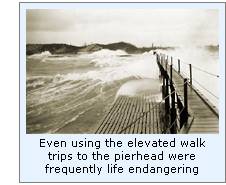 By virtue of its location at the eastern foot of the
lake, Michigan City was subject to numerous storms, and one can only
imagine the sight represented by this diminutive lady making her was out
to service the pierhead beacon in tempestuous weather. In typically
stoic terms a number of Miss Colfax's station log entries tell of her
difficulties, such as on September 18, 1872 when she reported "Cold
day. Heavy NW gale towards night. The waves dashing over both piers,
very nearly carrying me with them into the lake," and again on
September 29, when she wrote "Wind blowing a westerly gale all day
and still rising at 5 PM. Four vessels entered while the gale was at its
height & ran against the elevated walk, breaking it in again. Went
to the beacon tonight with considerable risk of life." By virtue of its location at the eastern foot of the
lake, Michigan City was subject to numerous storms, and one can only
imagine the sight represented by this diminutive lady making her was out
to service the pierhead beacon in tempestuous weather. In typically
stoic terms a number of Miss Colfax's station log entries tell of her
difficulties, such as on September 18, 1872 when she reported "Cold
day. Heavy NW gale towards night. The waves dashing over both piers,
very nearly carrying me with them into the lake," and again on
September 29, when she wrote "Wind blowing a westerly gale all day
and still rising at 5 PM. Four vessels entered while the gale was at its
height & ran against the elevated walk, breaking it in again. Went
to the beacon tonight with considerable risk of life."
By 1875, the west pier had been extended 800 feet
beyond the east pier to help shelter the opening from prevalent westerly
winds, and a lighthouse crew arrived and relocated the elevated walk
across the channel and re-erected it on the west pier along with 800
feet of new walk extending to shore. With completion of work on the
elevated walk, the beacon itself was loaded on a scow, and carried
across the channel and erected at the outer end of the pier and
connected to the elevated walk. This was no doubt a less than enjoyable
change for Harriet, as the main lighthouse was located across the
channel on the east shore, and thus she was forced to row her boat
across the channel to service the beacon every night. The following
year, the entire beacon was painted inside and out, and repairs made to
the elevated walk after it had been damaged by an unnamed vessel
entering the harbor the previous winter.
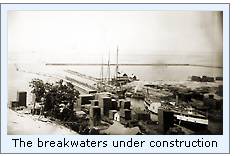 In 1882, work was well underway on erecting the 1,200
foot long timber crib east breakwater, and plans for the harbor were
further modified to include a 700-foot long detached breakwater to the
northwest of the pierhead entrance in a further attempt to stem sand
deposition. As a result of a major gale on the night if October 14,
1886, the pierhead beacon was ripped from the pier and destroyed by the
crashing waves. Deciding against reestablishment of the beacon, the
elevated walkway was removed from the west pier in 1891 and was shipped
by the Army Corps of Engineers to Ludington, where it was reassembled on
the south pier in that harbor. With frequent changes underway, the
Lighthouse Board and Army Corps of Engineers reached an agreement
whereby the Engineers would maintain a series of four tubular lanterns
on posts throughout the breakwater construction, thereby facilitation
frequent relocation of the lights as sections of breakwater were
completed. In 1882, work was well underway on erecting the 1,200
foot long timber crib east breakwater, and plans for the harbor were
further modified to include a 700-foot long detached breakwater to the
northwest of the pierhead entrance in a further attempt to stem sand
deposition. As a result of a major gale on the night if October 14,
1886, the pierhead beacon was ripped from the pier and destroyed by the
crashing waves. Deciding against reestablishment of the beacon, the
elevated walkway was removed from the west pier in 1891 and was shipped
by the Army Corps of Engineers to Ludington, where it was reassembled on
the south pier in that harbor. With frequent changes underway, the
Lighthouse Board and Army Corps of Engineers reached an agreement
whereby the Engineers would maintain a series of four tubular lanterns
on posts throughout the breakwater construction, thereby facilitation
frequent relocation of the lights as sections of breakwater were
completed.
With completion of the new outer east pierhead in
sight, the Lighthouse Board determined that the establishment of a
first-class fog signal at its outer end, and new beacons to mark the
ends of the west pierhead and breakwater would serve as valuable aids to
mariners, and thus a request for an appropriation of $5,500 was included
in the Board's annual report of 1894 for their erection. Without
Congressional action, the request was reiterated in each subsequent
annual report for the following five years. Congress finally responded
to the Board's repeated requests on June 6, 1900. when an act was
approved for establishing the new aids and immediately followed up with
the necessary appropriation. With the Engineers still working on the
outer end of the new breakwater, the work was postponed for two years
until the fall of 1903, when Ninth District Lighthouse Engineer Major
General Warren approved the detailed plans and specifications for the
new structures.
The required metal work for the three structures was
delivered to the lighthouse depot in Milwaukee over that winter, and
after loading in the lighthouse tender HYACINTH, was delivered to
Michigan City in June 1904, where a large work crew was waiting to help
unload the materials and begin construction. Over that summer, work in
the harbor reached a feverish pace as the construction crew worked on
erecting the three new structures and undertaking significant
modifications to the old dwelling.
 The new East Pierhead fog signal and light tower
consisted of a 24' square structure built of 3/16" steel plates
standing 14' 10" tall at the eaves. Within this structure, a pair
of horizontal boilers manufactured by Kingsford Foundry in Oswego, New
York were installed and equipped with a cam activated Crosby automatic
timing apparatus to sequence the signals to attain the designated
characteristic. Developing an operating pressure of 100 psi, the boilers
were connected to a single 10" locomotive steam whistle located on
the lakeward side of the roof, and their exhaust gases evacuated through
a single 24" diameter stack which extended up through the roof to a
conical rain cap standing 45' 3" above the deck of the timber pier.
Centered atop the hipped roof, an octagonal tower of 3/16" thick
steel plate was erected containing a set of spiral cast iron stairs with
5 landings rising from the pier deck to the gallery. With an inscribed
diameter of 10' 6", the tower contained 4 portholes of 14 ¾"
diameter to allow light into the structure, and was capped with 7'
1" diameter circular iron lantern with diagonal astragals. A cast
iron pedestal was erected at the center of the lantern, and prepared to
receive the Fifth Order Fresnel lens from the old main light on
completion of the construction. The entire building and tower were given
a coat of buff-colored paint with the exception of the lantern, which
was painted black to help it serve as a more effective day mark. The new East Pierhead fog signal and light tower
consisted of a 24' square structure built of 3/16" steel plates
standing 14' 10" tall at the eaves. Within this structure, a pair
of horizontal boilers manufactured by Kingsford Foundry in Oswego, New
York were installed and equipped with a cam activated Crosby automatic
timing apparatus to sequence the signals to attain the designated
characteristic. Developing an operating pressure of 100 psi, the boilers
were connected to a single 10" locomotive steam whistle located on
the lakeward side of the roof, and their exhaust gases evacuated through
a single 24" diameter stack which extended up through the roof to a
conical rain cap standing 45' 3" above the deck of the timber pier.
Centered atop the hipped roof, an octagonal tower of 3/16" thick
steel plate was erected containing a set of spiral cast iron stairs with
5 landings rising from the pier deck to the gallery. With an inscribed
diameter of 10' 6", the tower contained 4 portholes of 14 ¾"
diameter to allow light into the structure, and was capped with 7'
1" diameter circular iron lantern with diagonal astragals. A cast
iron pedestal was erected at the center of the lantern, and prepared to
receive the Fifth Order Fresnel lens from the old main light on
completion of the construction. The entire building and tower were given
a coat of buff-colored paint with the exception of the lantern, which
was painted black to help it serve as a more effective day mark.
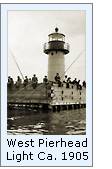 The new structure on the west pierhead took the form
of a buff painted cylindrical tower, which was a virtual duplicate of
the tower which had been erected at South Haven the previous year.
Standing 8' in diameter at the base, the structure tapered to a diameter
of 7' beneath the gallery, and was built of pre-formed steel plates
which progressively reduced in thickness from 5/16" at the base to
¼" below the gallery. Four 14 ¾ diameter porthole widows located
beneath the gallery allowed light to enter, guiding the way up the steel
stairs and ladder contained within. Atop the circular gallery, a black
painted decagonal iron lantern 7' in diameter housed a 5-day lens
lantern equipped with a ruby glass chimney to impart a red
characteristic to the light. Centered atop the lantern roof, a spherical
cast iron ventilator ball stood 27' 9" above the timber pier, and
was capped with a titanium-tipped lightning conductor. The new structure on the west pierhead took the form
of a buff painted cylindrical tower, which was a virtual duplicate of
the tower which had been erected at South Haven the previous year.
Standing 8' in diameter at the base, the structure tapered to a diameter
of 7' beneath the gallery, and was built of pre-formed steel plates
which progressively reduced in thickness from 5/16" at the base to
¼" below the gallery. Four 14 ¾ diameter porthole widows located
beneath the gallery allowed light to enter, guiding the way up the steel
stairs and ladder contained within. Atop the circular gallery, a black
painted decagonal iron lantern 7' in diameter housed a 5-day lens
lantern equipped with a ruby glass chimney to impart a red
characteristic to the light. Centered atop the lantern roof, a spherical
cast iron ventilator ball stood 27' 9" above the timber pier, and
was capped with a titanium-tipped lightning conductor.
To mark the end of the breakwater adjacent to the
harbor entry, a simple square concrete post was erected and topped by a
fixed red 5-day lens lantern.
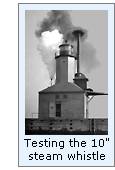 While the old lighthouse building would no longer be
needed to serve as an aid to navigation, with three keepers planned to
manage the aids at the station, the old structure underwent a complete
modification to convert it into a triplex dwelling, with 4 rooms for the
head keeper and 3 rooms for each of his two assistants. As part of the
reconfiguration, porches were added on each side of the building and the
bricks of the upper floor were covered with dark green painted shingles.
A coal shed and double privy were erected to the rear of the station and
concrete walks poured to connect the station buildings. Thomas J. Armstrong, who had been serving as keeper of
the South Manitou Light Station for the past ten years accepted a
transfer as the station's new keeper, and Harriet Colfax officially
retired from lighthouse service on October 13, after 43 years as the
steward of the Michigan City light station. The Fifth Order lens was removed from the lantern and
reestablished atop the new East Pierhead light and fog signal, and all
three of the new lights officially exhibited for the first time on the
evening of October 20, 1904. No longer serving any purpose, the square
wooden tower and lantern atop the dwelling were removed, and the
building re-roofed. While the old lighthouse building would no longer be
needed to serve as an aid to navigation, with three keepers planned to
manage the aids at the station, the old structure underwent a complete
modification to convert it into a triplex dwelling, with 4 rooms for the
head keeper and 3 rooms for each of his two assistants. As part of the
reconfiguration, porches were added on each side of the building and the
bricks of the upper floor were covered with dark green painted shingles.
A coal shed and double privy were erected to the rear of the station and
concrete walks poured to connect the station buildings. Thomas J. Armstrong, who had been serving as keeper of
the South Manitou Light Station for the past ten years accepted a
transfer as the station's new keeper, and Harriet Colfax officially
retired from lighthouse service on October 13, after 43 years as the
steward of the Michigan City light station. The Fifth Order lens was removed from the lantern and
reestablished atop the new East Pierhead light and fog signal, and all
three of the new lights officially exhibited for the first time on the
evening of October 20, 1904. No longer serving any purpose, the square
wooden tower and lantern atop the dwelling were removed, and the
building re-roofed.
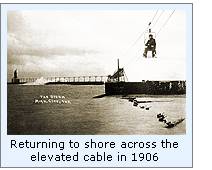 During a particularly devastating storm in the late
winter of 1905 - 1906, a large section of the outer east pier was
completely obliterated, leaving a gaping hole in structure, the west
pierhead light was inundated and pushed off its foundation and into the
harbor, forcing the keepers to make their was out to the fog signal by
way of the station boat. On the opening of the 1906 navigation season, a
lighthouse crew arrived at the station and erected a temporary post at
the end of the west pier from which a lens lantern was installed until
the cylindrical beacon could be retrieved and re-erected later that
year, and until the Army Corps of Engineers could effect a permanent
repair to the devastated east pier, a temporary 400-foot long wire cable
lifeline was installed to bridge the gap, and the keepers were forced to
take a "joy ride" across the gap, seated on a metal seat
suspended from the cable by pulleys. While this was likely considered a
less than enjoyable experience by the keepers, it was almost certainly
safer than attempting to scramble up the face of the east breakwater in
heavy seas from their bucking boat. Work on rebuilding the pier was
completed in 1907, and 1,000 feet of cast iron elevated walk were
erected to replace that which had been destroyed by the storm. 1907 was
also likely a memorable year for the keepers at Michigan City, as they
toiled to feed 29 tons of coal and 2 cords of wood into the hungry fog
signal boilers in order to keep their signal screaming its warning
across the lake a station record 275 hours. During a particularly devastating storm in the late
winter of 1905 - 1906, a large section of the outer east pier was
completely obliterated, leaving a gaping hole in structure, the west
pierhead light was inundated and pushed off its foundation and into the
harbor, forcing the keepers to make their was out to the fog signal by
way of the station boat. On the opening of the 1906 navigation season, a
lighthouse crew arrived at the station and erected a temporary post at
the end of the west pier from which a lens lantern was installed until
the cylindrical beacon could be retrieved and re-erected later that
year, and until the Army Corps of Engineers could effect a permanent
repair to the devastated east pier, a temporary 400-foot long wire cable
lifeline was installed to bridge the gap, and the keepers were forced to
take a "joy ride" across the gap, seated on a metal seat
suspended from the cable by pulleys. While this was likely considered a
less than enjoyable experience by the keepers, it was almost certainly
safer than attempting to scramble up the face of the east breakwater in
heavy seas from their bucking boat. Work on rebuilding the pier was
completed in 1907, and 1,000 feet of cast iron elevated walk were
erected to replace that which had been destroyed by the storm. 1907 was
also likely a memorable year for the keepers at Michigan City, as they
toiled to feed 29 tons of coal and 2 cords of wood into the hungry fog
signal boilers in order to keep their signal screaming its warning
across the lake a station record 275 hours.
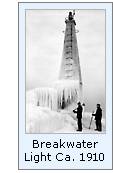 In yet another violent storm in 1909, the breakwater
light was destroyed, and the breakwater thus remaining unmarked until
1911, when a new pyramidal concrete structure was erected in is place.
The foundation of the new light consisted of a tank house standing 5'
7" by 7' 9" in plan, above which a four-sided concrete
structure stood 5' square at the base and tapered to 2' 6" square
at its upper level 16 feet above the foundation. Atop the tower at a
32-foot focal plane, a 50-candlepower 200 mm American Gas Accumulator
buoy lantern and sun valve was installed, visible for a distance of 16
miles in clear weather. In yet another violent storm in 1909, the breakwater
light was destroyed, and the breakwater thus remaining unmarked until
1911, when a new pyramidal concrete structure was erected in is place.
The foundation of the new light consisted of a tank house standing 5'
7" by 7' 9" in plan, above which a four-sided concrete
structure stood 5' square at the base and tapered to 2' 6" square
at its upper level 16 feet above the foundation. Atop the tower at a
32-foot focal plane, a 50-candlepower 200 mm American Gas Accumulator
buoy lantern and sun valve was installed, visible for a distance of 16
miles in clear weather.
In 1917, the color schemes of both the east and west
pierhead lights were changed, with the east pierhead fog signal being
painted white with a red roof and the west pierhead beacon painted red
with a black lantern. Also on May 17 of this year, the west pierhead
beacon was converted to acetylene power, with its characteristic changed
to a red flash of one second duration followed by an eclipse of 5
seconds.
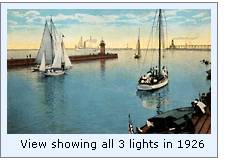 Municipal electricity was run out along the east pier
in 1933, allowing the automation of the fog signal through the
installation of a Cunningham air whistle and the replacement of the oil
vapor lamp in the Fifth Order Fresnel with a 5,000 candlepower
incandescent electric light bulb. Municipal electricity was run out along the east pier
in 1933, allowing the automation of the fog signal through the
installation of a Cunningham air whistle and the replacement of the oil
vapor lamp in the Fifth Order Fresnel with a 5,000 candlepower
incandescent electric light bulb.
Strapped for funds and the necessary manpower to
maintain the obsolete iron elevated walkway in the east pier, the Coast
Guard began considering removal of the structure in the mid 1980's.
Learning of the possibility that the historic walkway might be removed,
concerned Michigan City citizens were successful in having the walkway
listed on National Register of Historic places in 1988. Stuck between a
rock and a hard place, the Coast Guard offered to donate the walkway to
the City in 1991, and in 1994 the city launched a fund raising campaign
to raise the necessary funds for restoration of the structure.

Keepers of
this Light

Click here
to see a complete listing of all the keepers of the Michigan East
Breakwater Light compiled by Phyllis L. Tag of Great Lakes Lighthouse Research.

Finding this Light

Take 421 North into Michigan City, through downtown and to the
Lakeshore. As 421 intersects with Lakeshore Drive, continue North into
the park. The old shore lighthouse museum is to the left, and the pier
light is to the east and approximately 1/4 mile further north around the
Marina.

Reference Sources

Annual reports if the
Fifth Auditor of the Treasury, various, 1839 - 1852
Annual reports of the Lighthouse Board, various, 1853 – 1909
Annual reports of the Lighthouse Service, various, 1910 – 1929
Great Lakes Light Lists, various, 1849 – 1958
Journals of the US Congress, various, 1834 – 1876
Annual reports of the Lake Carriers Association, various, 1911
– 1944
Those Army Engineers, John W Larson, 1979
Women Who Kept The Lights, Mary Louise and J Candace Clifford,
1993
Keeper listings for this light appear courtesy of Great Lakes Lighthouse
Research
|
